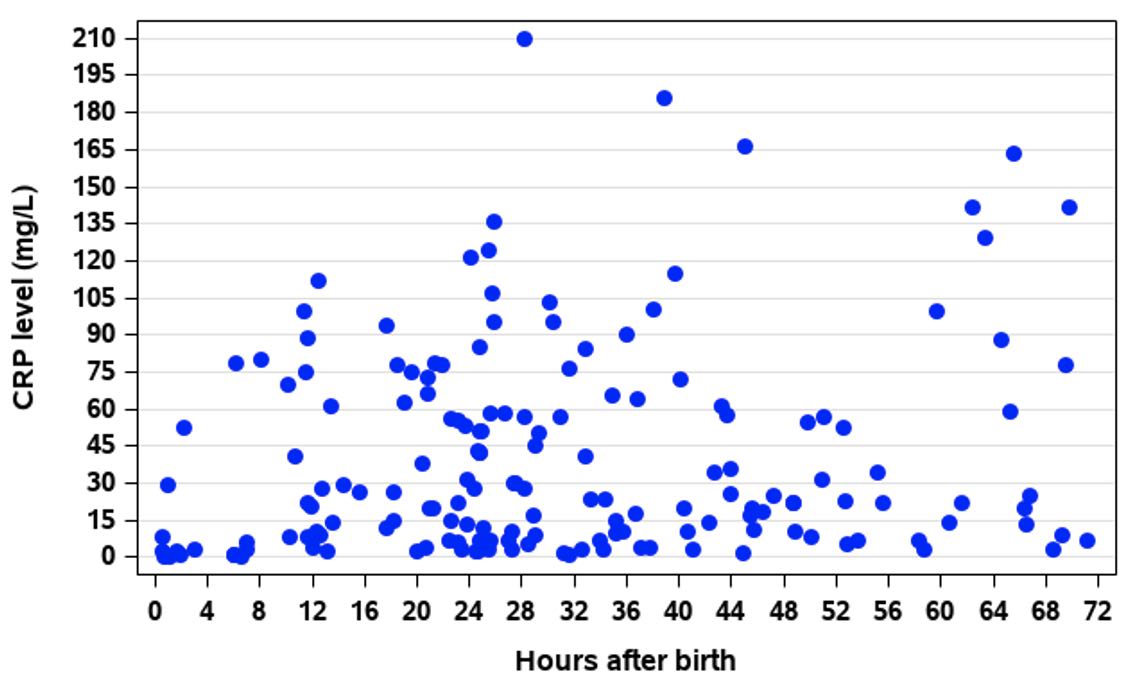Neonatal Infectious Diseases/Immunology
Category: Abstract Submission
Neonatal Infectious Diseases/Immunology: Sepsis & Antimicrobials
558 - Prevalence and utility of C-reactive protein (CRP) in neonatal early onset sepsis
Monday, April 25, 2022
3:30 PM - 6:00 PM US MT
Poster Number: 558
Publication Number: 558.428
Publication Number: 558.428
Ryan Kilpatrick, Duke University School of Medicine, Durham, NC, United States; Rachel G. Greenberg, Duke Clinical Research Institute, Durham, NC, United States; Nellie I. Hansen, RTI International, Research Triangle Park, NC, United States; Seetha Shankaran, Wayne State University School of Medicine, Austin, TX, United States; Waldemar A. Carlo, University of Alabama at Birmingham, Birmingham, AL, United States; Michael Cotten, Duke University School of Medicine, Durham, NC, United States; Barbara J. Stoll, China Medical Board, Atlanta, GA, United States

Ryan Kilpatrick, MD (he/him/his)
Fellow
Duke University School of Medicine
Durham, North Carolina, United States
Presenting Author(s)
Background: Early onset sepsis (EOS; within 72 hours of birth) is difficult to diagnose and a substantial cause of morbidity and mortality in neonates. CRP is an acute phase reactant proposed as a biomarker to improve diagnosis of EOS, but it is unknown whether there are associations between CRP levels and presentation and outcome of neonates with EOS.
Objective: Characterize CRP use and levels in neonates with proven EOS.
Design/Methods: Retrospective analysis of data from a surveillance study of neonates born at 18 Neonatal Research Network (NRN) clinical centers between 2015-2017 with gestational age (GA) ≥22 weeks and birth weight >400g who were diagnosed with EOS. We evaluated the proportion of neonates with EOS for whom CRP was obtained by center and year and compared demographics and clinical characteristics among neonates with and without CRP performed. We evaluated timing of CRP measurements (hours after birth). We compared median CRP levels among categories of neonatal demographic, clinical characteristics, pathogen type, and outcome.
Results: A total of 235 neonates at 18 centers had EOS, including 131 (56%) born < 37 weeks GA. At least one CRP was obtained for 96/235 (41%) neonates with EOS. The proportion of neonates with any CRP varied by center (Figure 1). There was no significant difference in percentage of neonates with CRP obtained by study year. Characteristics of neonates with EOS who had CRP obtained did not differ from those without CRP obtained. There was no relationship between the time CRP was obtained and the level (Figure 2). In neonates with at least one CRP obtained, no differences were found in the distribution of CRP levels by demographic and clinical characteristics examined. CRP levels were significantly higher for neonates with multiple clinical signs (Table 1). CRP levels were not significantly different in gram positive (n=47) compared to gram negative (n=43) EOS [median (p25, p75): 43 (15, 72) vs 51 (12, 89)] or preterm neonates who died (n=13) compared to those who survived (n=46) [median (p25, p75): 38 (20, 95) vs 28 (8, 70)].Conclusion(s): In this multi-center cohort of neonates with EOS, use of CRP varied markedly by center. CRP levels did not differ by time of testing, demographic and clinical characteristics examined, pathogen type, or death. Results should be viewed in the context of the small number of subjects. Further prospective studies including controls are warranted to evaluate the diagnostic utility of CRP.
Ryan Kilpatrick CVRyan Kilpatrick - CV 12.23.2021.pdf
Figure 2. CRP level by number of hours taken after birth. All values available are shown including multiple values per neonate where applicable. A total of 170 CRP levels were obtained for 96 neonates; CRP level was missing for 3 observations.
Objective: Characterize CRP use and levels in neonates with proven EOS.
Design/Methods: Retrospective analysis of data from a surveillance study of neonates born at 18 Neonatal Research Network (NRN) clinical centers between 2015-2017 with gestational age (GA) ≥22 weeks and birth weight >400g who were diagnosed with EOS. We evaluated the proportion of neonates with EOS for whom CRP was obtained by center and year and compared demographics and clinical characteristics among neonates with and without CRP performed. We evaluated timing of CRP measurements (hours after birth). We compared median CRP levels among categories of neonatal demographic, clinical characteristics, pathogen type, and outcome.
Results: A total of 235 neonates at 18 centers had EOS, including 131 (56%) born < 37 weeks GA. At least one CRP was obtained for 96/235 (41%) neonates with EOS. The proportion of neonates with any CRP varied by center (Figure 1). There was no significant difference in percentage of neonates with CRP obtained by study year. Characteristics of neonates with EOS who had CRP obtained did not differ from those without CRP obtained. There was no relationship between the time CRP was obtained and the level (Figure 2). In neonates with at least one CRP obtained, no differences were found in the distribution of CRP levels by demographic and clinical characteristics examined. CRP levels were significantly higher for neonates with multiple clinical signs (Table 1). CRP levels were not significantly different in gram positive (n=47) compared to gram negative (n=43) EOS [median (p25, p75): 43 (15, 72) vs 51 (12, 89)] or preterm neonates who died (n=13) compared to those who survived (n=46) [median (p25, p75): 38 (20, 95) vs 28 (8, 70)].Conclusion(s): In this multi-center cohort of neonates with EOS, use of CRP varied markedly by center. CRP levels did not differ by time of testing, demographic and clinical characteristics examined, pathogen type, or death. Results should be viewed in the context of the small number of subjects. Further prospective studies including controls are warranted to evaluate the diagnostic utility of CRP.
Ryan Kilpatrick CVRyan Kilpatrick - CV 12.23.2021.pdf
Figure 2. CRP level by number of hours taken after birth. All values available are shown including multiple values per neonate where applicable. A total of 170 CRP levels were obtained for 96 neonates; CRP level was missing for 3 observations.

